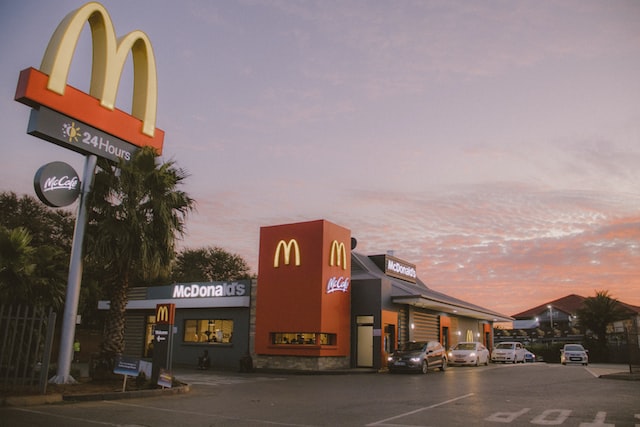Before we get into the specifics of McDonald’s, let’s understand competitor analysis. Competitor analysis is a strategic research method companies use to identify, evaluate, and understand their current and potential competitors within the market. It’s an essential business strategy component and instrumental in understanding the industry landscape.
The process usually involves the following steps:
- Identifying Key Competitors: The first step is to identify who your competitors are. These may be direct competitors (those who offer the same or similar products or services as you) or indirect competitors (those who offer different products or services but compete for the same consumer dollar).
- Analyzing Competitors’ Strategies and Objectives: Once competitors are identified, the next step is to understand their business strategies and objectives. This may involve analyzing their marketing materials, financial performance, customer reviews, or any public information available about the company.
- Assessing Competitors’ Strengths and Weaknesses: This step involves evaluating the identified competitors’ strengths and weaknesses. Strengths include unique products or services, strong brand recognition, and superior customer service. Weaknesses include poor product quality, weak customer service, or high prices.
- Understanding Competitors’ Products/Services: Understanding what your competitors offer and how your products or services compare is important. This could involve looking at features, quality, pricing, customer service, and marketing strategies.
- Observing Competitors’ Reaction Patterns: Some companies react more aggressively than others when faced with competition. Understanding these patterns lets you predict how these companies might respond to your business strategies.
- Drawing Conclusions and Formulating Strategy: The final step is to take all the information gathered from the analysis, draw meaningful conclusions, and use those to formulate or adjust your business strategies.
The main goal of a competitor analysis is to understand the competitive landscape, spot opportunities, and threats, and position your company most advantageously. It helps to inform strategic decisions, from product development to marketing and sales efforts. Now let’s do a competitor analysis of McDonald’s.
Here is the competitor analysis of McDonald’s
Burger King
McDonald’s and Burger King are two of the most recognizable brands in the fast-food industry, both globally and in the United States. Both serve a menu of mainly hamburgers, chicken sandwiches, fries, and beverages, and both offer breakfast items and desserts. However, they compete in several distinct ways:
1. Product Differentiation:
Although both restaurants serve similar menu items, each has signature dishes that set them apart. McDonald’s is known for its Big Mac, Quarter Pounder, and Chicken McNuggets, while Burger King is recognized for its Whopper and flame-grilled burgers.
2. Pricing Strategy:
Both chains offer value menus and promotional deals. They strive to keep their prices competitive to attract customers looking for affordable dining options.
3. Branding and Advertising:
McDonald’s and Burger King employ different branding strategies. McDonald’s marketing often emphasizes the universality of its offerings and the joy associated with its brand, using slogans like “I’m Lovin’ It.” In contrast, Burger King’s marketing often uses humor and irreverence, with slogans like “Have It Your Way” emphasizing customization.
4. Menu Innovation:
Both chains regularly introduce new items to their menus to attract customers and keep up with food trends. For example, both chains have introduced plant-based burger options in response to the growing demand for vegetarian and vegan food options.
5. Technology and Customer Experience:
Both companies have invested in technology to improve the customer experience. They’ve introduced features such as mobile apps for ordering and rewards programs, self-service kiosks, and partnerships with delivery services.
6. Global Presence:
Both chains have a significant global presence, but McDonald’s has more restaurants worldwide. As of 2021, McDonald’s had more than 39,000 locations globally, compared to over 18,000 for Burger King. This gives McDonald’s a wider reach and makes it more accessible to customers in many parts of the world.
7. Operational Strategy:
While both chains focus on fast service, McDonald’s has traditionally emphasized operational efficiency, consistency, and speed, while Burger King has emphasized customization and taste (flame-grilled).
Wendy’s
McDonald’s and Wendy’s are two of the biggest fast-food chains in the world, both offering a similar menu of hamburgers, chicken sandwiches, fries, beverages, and desserts. However, there are several key areas in which they compete:
1. Product Differentiation:
Both chains have signature items that set them apart. McDonald’s is known for its Big Mac, Quarter Pounder, and Chicken McNuggets, while Wendy’s is famous for its square hamburgers, sea salt fries, and Frosty desserts. Wendy’s also emphasizes its use of fresh, never frozen, beef in its burgers, which it uses as a point of differentiation from McDonald’s.
2. Pricing Strategy:
Wendy’s and McDonald’s offer value menus priced at $1 or slightly higher, trying to cater to budget-conscious customers. McDonald’s, with its “Dollar Menu” and equivalent promotions, and Wendy’s, with its “4 for $4” meal deal, compete to provide the most attractive value offerings.
3. Branding and Advertising:
Both chains employ distinct branding strategies. McDonald’s uses the “I’m Lovin’ It” slogan and the iconic Ronald McDonald character, emphasizing fun and universal appeal. Wendy’s branding often emphasizes quality, with slogans like “Quality is our Recipe.” Wendy’s has also gained attention for its humorous and sometimes aggressive social media presence.
4. Menu Innovation:
Both chains regularly introduce new and limited-time items to their menus to keep customers interested and cater to changing consumer preferences. For example, both chains have recently introduced plant-based burger options in response to the growing demand for vegetarian and vegan options.
5. Technology and Customer Experience:
Both companies have invested in technology to improve the customer experience. They’ve both developed mobile apps that allow customers to place orders for pickup or delivery and offer loyalty rewards programs.
6. Global Presence:
As of 2021, McDonald’s had a more extensive global presence than Wendy’s, with more than 39,000 locations in over 100 countries compared to over 6,700 Wendy’s locations, primarily in North America. This global reach gives McDonald’s an advantage in accessibility and brand recognition.
7. Operational Strategy:
Both chains strive to offer fast service and a consistent product. McDonald’s has historically strongly emphasized speed and efficiency, while Wendy’s has emphasized quality ingredients and fresh preparation more.
KFC
McDonald’s and KFC (Kentucky Fried Chicken) are both prominent players in the fast-food industry, though their main offerings are quite different. McDonald’s is most well-known for its burgers and fries, while KFC specializes in fried chicken. Here’s how these two fast-food giants compete:
1. Product Differentiation:
While both chains serve various fast food, their signature items differ. McDonald’s is recognized for its Big Mac, Chicken McNuggets, and fries, whereas KFC is renowned for its Original Recipe fried chicken. KFC also offers other chicken products, sides like mashed potatoes and gravy, and biscuits, providing a different type of meal than what is generally available at McDonald’s.
2. Pricing Strategy:
Both McDonald’s and KFC strive to offer value to their customers. McDonald’s has a range of price points, including the affordable options on its “Dollar Menu,” whereas KFC often promotes meal deals and family buckets that provide value for larger groups.
3. Branding and Advertising:
Each chain has its unique branding strategy. McDonald’s emphasizes fun and universal appeal with its “I’m Lovin’ It” slogan and the iconic Ronald McDonald. KFC’s branding often revolves around its “finger-licking good” fried chicken and the image of founder Colonel Sanders.
4. Menu Innovation:
Both chains consistently innovate their menus to cater to changing customer preferences. This includes limited-time offerings, seasonal items, and new product introductions. For example, both chains have introduced plant-based options in response to the growing demand for vegetarian and vegan alternatives.
5. Global Presence:
As of 2021, McDonald’s had a more significant global presence than KFC, with over 39,000 locations worldwide compared to KFC’s over 24,000. McDonald’s extensive international footprint provides an advantage in global brand recognition and reach.
6. Technology and Customer Experience:
Both chains have embraced technology to enhance the customer experience. They have implemented online ordering, delivery partnerships with services like Uber Eats and DoorDash, and mobile apps that offer rewards programs.
7. Operational Strategy:
Both chains have distinct operational strategies. McDonald’s has traditionally focused on speed, efficiency, and consistency. In contrast, KFC focuses more on product quality and taste, emphasizing its “11 herbs and spices” recipe and freshly prepared chicken.
Subway
McDonald’s and Subway are among the largest fast-food chains worldwide, but their menus and restaurant concepts differ. McDonald’s is known for its burgers, fries, and chicken items, while Subway is recognized for its made-to-order sandwiches and salads. Here’s how these two fast-food giants compete:
1. Product Differentiation:
McDonald’s and Subway have very different menu offerings, with McDonald’s focused on items like burgers, fries, and chicken nuggets, while Subway offers customizable sandwiches and salads. Subway’s use of fresh ingredients and the ability for customers to customize their meals is a significant point of differentiation from McDonald’s.
2. Pricing Strategy:
Both chains offer value options to attract budget-conscious customers. McDonald’s has value meals and a range of price points, while Subway often promotes its “Five Dollar Footlong” and other value meal deals.
3. Branding and Advertising:
McDonald’s is recognized globally with its “Golden Arches,” Ronald McDonald character, and the “I’m Lovin’ It” slogan. On the other hand, Subway has the “Eat Fresh” slogan, emphasizing its commitment to fresh ingredients. Both chains use their unique branding to appeal to different segments of the fast-food market.
4. Menu Innovation:
McDonald’s and Subway regularly introduce new items to their menus to keep customers interested. They also both cater to changing consumer preferences, including healthier options. McDonald’s has added salads, fruit, and leaner proteins. At the same time, Subway offers a range of vegetables and lean proteins and has introduced wraps in addition to its traditional submarine sandwiches.
5. Global Presence:
Both chains have a substantial international presence. As of 2023, Subway and McDonald’s have almost a similar number of locations globally (~39000). However, McDonald’s has a stronger presence in some key markets and often generates higher revenue due to its higher average sales per unit.
6. Convenience and Service:
Subway’s service model is centered on customization and the visual preparation of food. In contrast, McDonald’s focuses on speed and convenience, with many locations offering drive-thru service, which Subway traditionally does not provide.
7. Technology and Customer Experience:
Both McDonald’s and Subway have embraced technology to enhance the customer experience. They offer mobile apps for ordering and loyalty programs and partner with delivery services to deliver meals.
8. Healthier Options:
Subway has carved a niche by offering healthier fast-food alternatives and providing detailed nutritional information to its customers. McDonald’s has also moved in this direction, but Subway’s branding is more closely tied to healthier eating.
Taco Bell
McDonald’s and Taco Bell are two leading fast-food chains with different specialties. McDonald’s is primarily known for its burgers, fries, and chicken items, while Taco Bell specializes in Tex-Mex food like tacos, burritos, and quesadillas. Here’s how these two compete:
1. Product Differentiation:
Both chains offer unique menu items that cater to different consumer tastes. McDonald’s is recognized for its Big Mac, Chicken McNuggets, and fries, while Taco Bell is known for its Crunchy Tacos, Doritos Locos Tacos, and Crunchwrap Supreme.
2. Pricing Strategy:
McDonald’s and Taco Bell offer value menus and deals to attract budget-conscious consumers. McDonald’s has its “Dollar Menu” and combo meals, while Taco Bell provides a “Cravings Value Menu” with items priced at $1.
3. Branding and Advertising:
Each chain has a distinctive brand identity. McDonald’s is associated with the Golden Arches, Ronald McDonald, and its “I’m Lovin’ It” slogan, which conveys a universal, family-friendly appeal. Taco Bell, on the other hand, often targets a younger demographic with slogans like “Live Mas” and edgy, humorous marketing campaigns.
4. Menu Innovation:
Both chains consistently introduce new items and limited-time offers to their menus. Taco Bell often experiments with unique, innovative products like the Doritos Locos Tacos. At the same time, McDonald’s also regularly introduces new items and has made moves to cater to health-conscious consumers with options like salads and fruit.
5. Global Presence:
As of 2021, McDonald’s had a more extensive global presence than Taco Bell, with over 39,000 locations in more than 100 countries, compared to Taco Bell’s roughly 7,000 locations. This wider global footprint gives McDonald’s an advantage in accessibility and brand recognition.
6. Technology and Customer Experience:
McDonald’s and Taco Bell have embraced technology to enhance the customer experience. They have implemented mobile apps for ordering, rewards programs, and partnerships with delivery services like Uber Eats and DoorDash.
7. Breakfast Offerings:
While McDonald’s has long been a significant player in the fast-food breakfast market, Taco Bell introduced a national breakfast menu in the U.S. in 2014, directly competing with McDonald’s established breakfast offerings.









